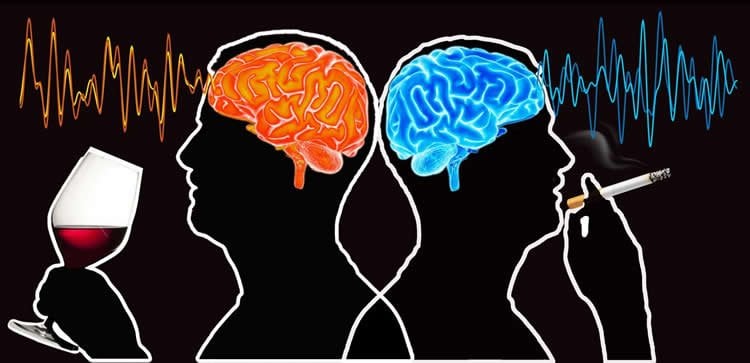Summary: A new study reveals researchers have identified areas of the brain which are different in those who regularly smoke and drink alcohol. Researchers discovered the medial orbitofrontal cortex, and area of the brain implicated in reward, has higher functional connectivity in drinkers. In those who smoke, the lateral orbiotfrontal cortex, an area of the brain linked to impulsive behavior, has lower functional connectivity. The study suggests nicotine may increase overall brain connectivity, which may lead to increased smoking behaviors.
Source: University of Warwick.
Academics at the University of Warwick have found that low functional connectivity of the lateral orbitofrontal cortex that is associated with the tendency to smoke is associated with increased impulsiveness – which may contribute to the tendency to smoke. The high connectivity of the reward-related medial orbitofrontal cortex in drinkers may increase the tendency to be attracted to the reward of alcohol consumption.
A new study by Professor Jianfeng Feng, Professor Edmund Rolls from the Department of Computer Science at the University of Warwick, in collaboration with Dr. Wei Cheng from Fudan University, China, examined the neural mechanisms underlying two key types of substance use behavior, smoking and drinking.
In 2000 participants they found that smokers had low functional connectivity in general, and especially in the lateral orbitofrontal cortex, a region of the brain associated with impulsive behavior. This suggests that people who smoke may do so to increase their overall brain connectivity with the stimulating effect of nicotine; and that being impulsive may be a factor leading to smoking.
Drinkers of alcohol had high overall brain connectivity, especially in the medial orbitofrontal cortex, a region implicated in reward. It is suggested that the high connectivity of this reward-related brain region may be a factor in attracting some individuals to alcohol.
Importantly the extent of these functional connectivity changes in the brains of drinkers and smokers correlated with the amount of alcohol and nicotine being consumed. Critically they were even detectable in individuals smoking only a few cigarettes or drinking one unit of alcohol every day.
Another key discovery is that it was possible to relate the connectivity at age 14 to who would smoke or drink at age 19. This opens up the issue of causality in addiction.
Professor Edmund Rolls, from the University of Warwick’s Department of Computer Science, comments: “These discoveries help to show that there are different neural bases of different types of addiction, and that the orbitofrontal cortex, a key brain region in emotion, is implicated in these two types of addiction.”

Professor Jianfeng Feng, from the University of Warwick’s Department of Computer Science comments: “These findings could have important public health implications, as both drinking and smoking affect a large population worldwide. According to a WHO investigation, there are over 1.1 billion people who smoke tobacco in the world, and more than 7 million people die each year due to the use of tobacco. As well as 2.3 billion people worldwide who are currently drinkers, with more than a quarter of all 15-19 year old teenagers drinking. More than 3 million people die as a result of the harmful use of alcohol each year.
“These are key discoveries that advance our understanding of the neurological bases of smoking and drinking and also provide new evidence on the different neurological mechanisms that are related to these two types of human addictive behavior, smoking and drinking, and these advances have implications for prevention and treatment of these two substance use.”
Source: Alice Scott – University of Warwick
Publisher: Organized by NeuroscienceNews.com.
Image Source: NeuroscienceNews.com image is credited to University of Warwick.
Original Research: Open access research for “Decreased brain connectivity in smoking contrasts with increased connectivity in drinking” by Wei Cheng, Edmund T Rolls, Trevor W Robbins, Weikang Gong, Zhaowen Liu, Wujun Lv, Jingnan Du, Hongkai Wen, Liang Ma, Erin Burke Quinlan, Hugh Garavan, Eric Artiges, Dimitri Papadopoulos Orfanos, Michael N Smolka, Gunter Schumann, Keith Kendrick, and Jianfeng Feng in eLife. Published January 8 2019.
doi:10.7554/eLife.40765
[cbtabs][cbtab title=”MLA”]University of Warwick”How the Brain Decides Whether to Hold ’em or Fold ’em.” NeuroscienceNews. NeuroscienceNews, 7 January 2019.
<https://neurosciencenews.com/smoking-drinking-brain-10456/>.[/cbtab][cbtab title=”APA”]University of Warwick(2019, January 7). How the Brain Decides Whether to Hold ’em or Fold ’em. NeuroscienceNews. Retrieved January 7, 2019 from https://neurosciencenews.com/smoking-drinking-brain-10456/[/cbtab][cbtab title=”Chicago”]University of Warwick”How the Brain Decides Whether to Hold ’em or Fold ’em.” https://neurosciencenews.com/smoking-drinking-brain-10456/ (accessed January 7, 2019).[/cbtab][/cbtabs]
Abstract
Decreased brain connectivity in smoking contrasts with increased connectivity in drinking
In a group of 831 participants from the general population in the Human Connectome Project, smokers exhibited low overall functional connectivity, and more specifically of the lateral orbitofrontal cortex which is associated with non-reward mechanisms, the adjacent inferior frontal gyrus, and the precuneus. Participants who drank a high amount had overall increases in resting state functional connectivity, and specific increases in reward-related systems including the medial orbitofrontal cortex and the cingulate cortex. Increased impulsivity was found in smokers, associated with decreased functional connectivity of the non-reward-related lateral orbitofrontal cortex; and increased impulsivity was found in high amount drinkers, associated with increased functional connectivity of the reward-related medial orbitofrontal cortex. The main findings were cross-validated in an independent longitudinal dataset with 1176 participants, IMAGEN. Further, the functional connectivities in 14-year-old non-smokers (and also in female low-drinkers) were related to who would smoke or drink at age 19. An implication is that these differences in brain functional connectivities play a role in smoking and drinking, together with other factors.






